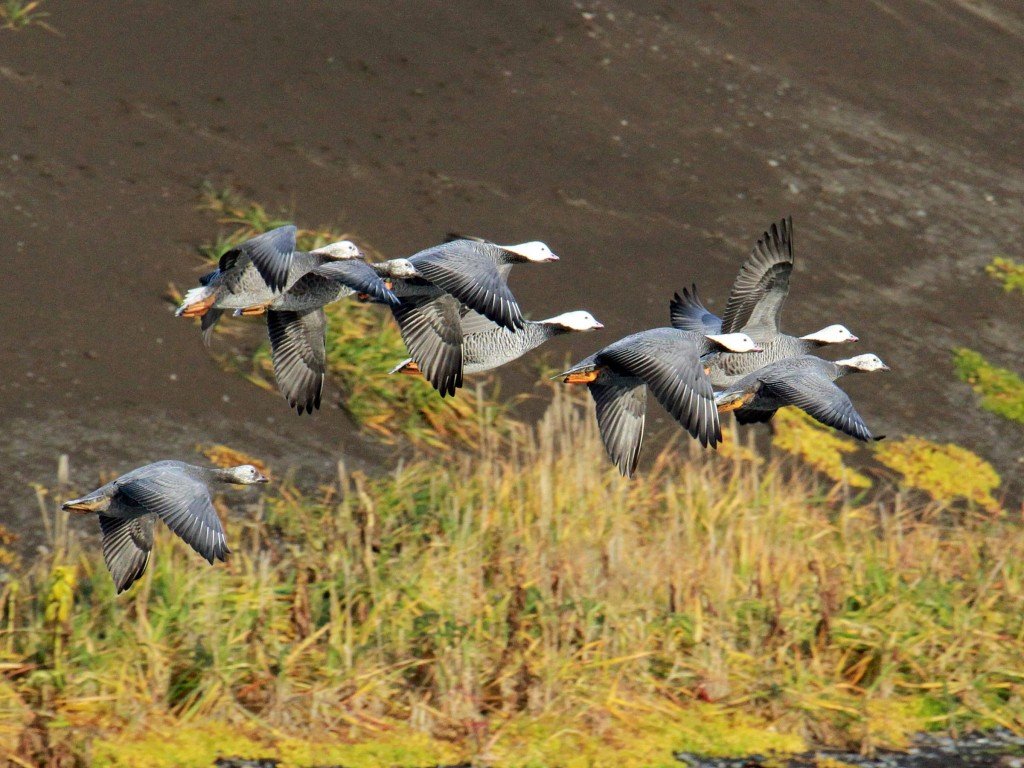Emperor Goose

The Emperor Goose (Chen canagicus) is an attractive snow goose relative that’s been referred to in Alaska as the “beach goose.” Sexes look similar, and are characterized by the white crown extending down the back of the neck and displays a pitch-black bib down the front of the neck. The white plumage usually stained ruddy, orange, or yellow due to foraging for mussels, barnacles, and clams in waters that are rich in iron oxide during the breeding season. This goose is somewhat stocky, having a short, blunt, pink bill with yellow-orange legs and feet. The body shows blocky vermiculation with beautiful shades of gray, black, and brown. Juvenile Emperor Geese display similar body plumage to adults, but slightly darker plumage covering the entire body, with dull gray-blue bill.
Breeding and wintering grounds are fully western Alaska to northeastern Siberia. Their preferred habitat is near brackish waters and rocky shorelines where they nest on the ground. Breeding grounds are found on the western coast of Alaska (Bering Sea region) and a few individuals reside on the northeastern coast of Russia near the Chukotka Peninsula and the Anadyr lowlands. Emperor Geese mate for life, with each in the pair taking on separate responsibilities. It has been reported that while the female makes the nest, the male will stand guard and warn the female of any predators in the area.
The Emperor Goose does not migrate far to reach their wintering grounds on the Aleutian Islands in Alaska. Both Russia and Alaska populations have been observed in this area. For the first few years of life, young of this species will migrate, winter, and forage together. Family groups will be aggressive to other families if they forage too close but are otherwise tolerant to their species during this time, as well as Cackling, Snow, and Brant Geese. While they do eat animal matter, their preferred diet consists of grasses.
Emperor goose hunting during the fall-winter season has been opened since about 2018 to Alaska residents by registration permits and to only 25 nonresidents annually by drawing permit. The Emperor Goose bag limits is ONE annually per permit. Hunting was closed in 1986 due to drastic population declines. Three decades of meaningful conservation effort went into recovering emperor geese populations to acceptable thresholds for limited hunting. Still considered vulnerable to overharvest, annual harvest quota is 1000 annually. Total seasonal sport-related bag by has been well under 50% since reopening, and it is hoped that non-resident draw tags will increase so that all waterfowl hunters may enjoy hunting this species.
Physiologically, the Emperor Goose displays sexual dimorphism, with males generally larger than females. Adult males feature a glossy black head, neck, and bill that starkly contrast against their immaculate white bodies. Meanwhile, females and immature individuals possess a more subdued palette, with brownish-gray tones replacing the striking black of the males. The species exhibits a remarkable adaptation to its coastal habitat, where it thrives in the dynamic interface between land and water.
Emperor Geese are highly social birds, often seen in flocks during various phases of their annual life cycle. During the breeding season, which typically occurs in the spring and early summer, these geese engage in communal nesting. They select nest sites in close proximity to each other, fostering a sense of community. Nesting locations are carefully chosen in areas with access to freshwater and an abundance of suitable vegetation for both feeding and cover.
Dietary habits of the Emperor Goose contribute to its ecological niche. These omnivores feed on a diverse array of sustenance, including aquatic vegetation, mollusks, and invertebrates. Their foraging expeditions often take them to intertidal zones and shallow coastal waters, where they deftly navigate the delicate balance between land and sea.
Despite the captivating allure of the Emperor Goose, its populations face challenges that necessitate conservation attention. Habitat degradation due to human activities, including oil and gas development, poses a significant threat. Additionally, indigenous hunting pressures have historically impacted the species, emphasizing the importance of sustainable management practices.
Conservation efforts have been implemented to address these challenges. Collaborative initiatives between wildlife management agencies, conservation organizations, and local communities aim to protect and restore critical habitats while promoting responsible hunting practices. Monitoring population dynamics and migration patterns further contribute to informed conservation strategies for the Emperor Goose, ensuring the continued existence of this remarkable species in its coastal domains.



















